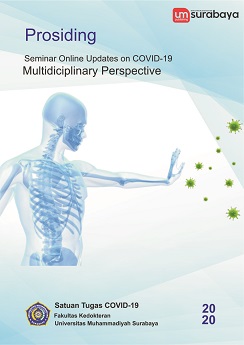Manifestasi COVID-19 pada Neurologi
Abstrak
AbstractSince its appearance at the end of 2019 until now, COVID-19 has spread to all over the world
including Indonesia, which is still battling the virus infection with numbers that have not
decreased. In its journey, COVID-19 has manifested itself in various body systems, including
the nerves. Many case reports and studies mentioned neurological clinical symptoms in
COVID-19 patients, ranging from mild ones such as headaches, anosmia, to severe symptoms
such as stroke, meningitis, to Guillain Barre Syndrome. This article discusses how SARS-CoV-
2 can reach the nervous system, and what neurological manifestations can occur, sourced from
various retrospective studies, reviews, and case reports.
Keywords: COVID-19, nervus system, neurology clinical symptoms
Referensi
Ahmed MU, Hanif M, Ali MJ, et al. Neurological Manifestations of COVID-19 (SARS-CoV-2):
A Review. Frontiers in Neurology. (2020). doi: 103389/fneur.2020.00518
Li YC, Bai WZ, Hashikawa T. The neuroinvasive potential of SARS-CoV2 may play a role in
the respiratory failure of COVID-19 patients. J Med Virol. (2020) 92:552–5. doi:
1002/jmv.25728
Bohmwald K, Gálvez NMS, RÃos M, Kalergis AM. Neurologic alterations due to respiratory
virus infections. Front Cell Neurosci. (2018) 12:386. doi: 10.3389/fncel.2018.00386
Zhang C, Wu Z, Li JW, Zhao H, Wang GQ. The cytokine release syndrome (CRS) of severe
COVID-19 and Interleukin-6 receptor (IL6R) antagonist Tocilizumab may be the key to reduce
the mortality. Int J Antimicrob Agents. (2020) 105954. doi: 10.1016/j.ijantimicag.2020.1 05954
Sheraton M, Deo N, Kashyap R, et al. A Review of Neurological Complications of COVID-19.
Mao L, Jin H, Wang M, et al. Neurologic manifestations of hospitalized patients with coronavirus
disease 2019 in Wuhan, China. JAMA Neurol. (2020). e201127. doi: 10.1001/jamaneurol.202
1127
Klopfenstein T, Kadiane-Oussou NJ, Toko L, et al. Features of anosmia in COVID-19. Med Mal
Infect. (2020). doi: 10.1016/j.medmal.2020.04.006.
Nath A. Neurologic complications of coronavirus infections. Neurology. (2020) 94:809–10.
Sedaghat Z, Karimi N. Guillain Barre syndrome associated with COVID-19 infection: a case
report. J Clin Neurosci. (2020). doi: 10.1016/j.jocn.2020.04.062
Zhao H, Shen D, Zhou H, Liu J, Chen S. Guillain-Barré syndrome associated with SARS-CoV-
infection: causality or coincidence? Lancet Neurol. (2020) 19:383–4.
Gutiérrez-Ortiz C, Méndez A, Rodrigo-Rey S, Pedro-Murillo ES, Bermejo-Guerrero L, GordoMañas R, et al. Miller Fisher Syndrome and polyneuritis cranialis in COVID-19. Neurology.
(2020).
Baig AM, Khaleeq A, Ali U, Syeda H. Evidence of the COVID-19 Virus Targeting the CNS:
Tissue Distribution, Host−Virus Interaction, and Proposed Neurotropic Mechanisms. ACS
Chemical Neuroscience, 2020.Divani AA, Andalib S, Napoli MD, et al. Coronavirus Disease
and Stroke: Clinical Manifestations and Pathophysiological Insights. Journal of Stroke and
Cerebrovascular Diseases. Vol. 29, No. 8 (August), 2020: 104941
Hess DC, Eldahshan W, Rutkowski E. COVID-19-related stroke. Transl Stroke Res. (2020)
:322-5
Carod-Artal FJ. Neurological complications of coronavirus and COVID-19. Complicaciones
neurológicas por coronavirus y COVID19. Revr Neurol. (2020)






